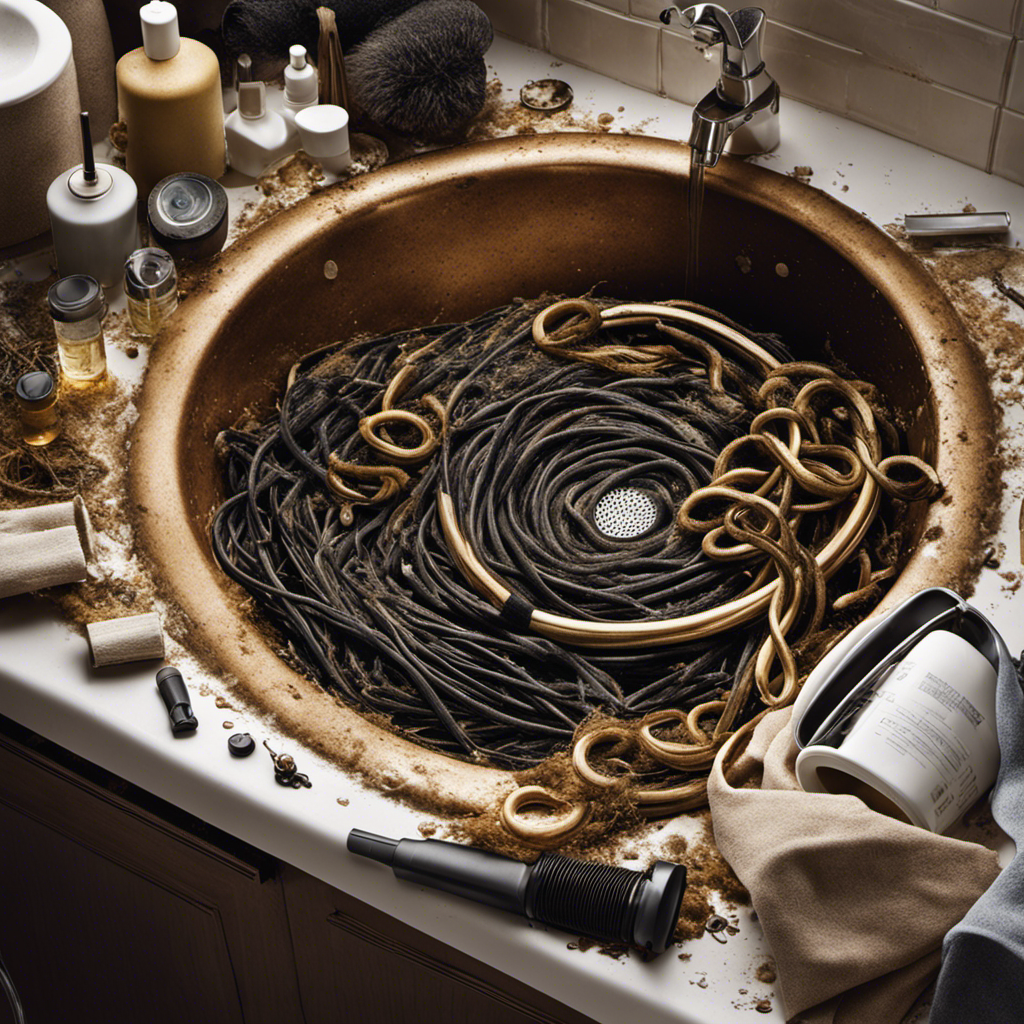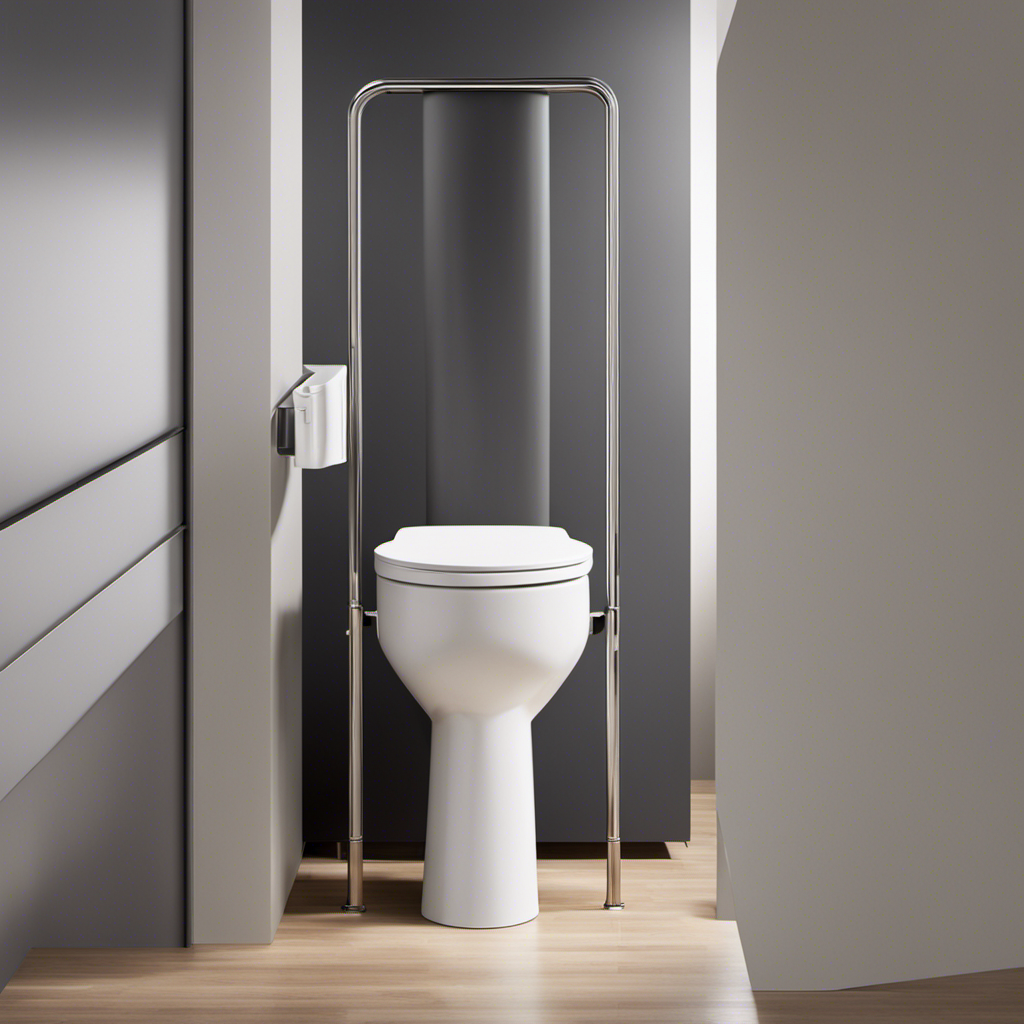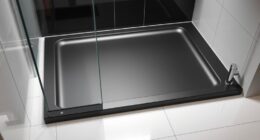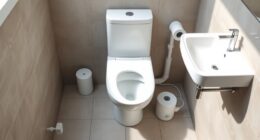Bathroom drain clogs are a common nuisance that can disrupt daily routines and cause frustration. They can be caused by a variety of factors, such as hair, soap scum, small objects, and damaged pipes.
Imagine a river flowing freely until it encounters a dam, blocking its path. Similarly, these clogs obstruct the smooth flow of water down the drain.
Fortunately, there are solutions available to unclog drains, both chemically and mechanically.
This article will explore the common causes of bathroom drain clogs and provide effective solutions to keep the water flowing smoothly.
Key Takeaways
- Hair, soap scum, and small objects are common causes of bathroom drain clogs.
- Regular cleaning and maintenance can help prevent and clear clogs.
- Chemicals like bleach and Coca-Cola can be used to unclog drains, but caution should be exercised.
- Mechanical methods like plungers, hooks, and plumber’s snakes can also be effective in removing clogs.
Common Causes of Bathroom Drain Clogs
Hair clumps together when wet, increasing the likelihood of clogging drains. This is one of the common causes of bathroom drain clogs. When hair goes down the drain, it can collect other hair and soap scum, creating a blockage over time.
Apart from hair and soap scum, objects like earring stoppers can also cause clogs in bathroom drains. These small items can easily get stuck in the pipes, obstructing the flow of water.
Additionally, damaged pipes can contribute to drain clogs. Rust buildup, dented pipes, and worn-out pipe joints can restrict water flow and lead to blockages. It is important to address these issues promptly to prevent further damage and ensure the proper functioning of bathroom drains.
How a Bathroom Drain Works
Gravity and pressure work together to facilitate the functioning of a bathroom drain. When water is poured down the sink, it picks up speed as it falls down the drain due to gravity. This force helps to push the water and any waste through the drainpipes and towards the main sewer line.
However, it is important to note that a bathroom drain cannot function properly without the presence of plumbing vents. These vents play a crucial role in maintaining water flow and preventing vacuum within the drain system. Plumbing vents allow air to enter the pipes, equalizing the pressure and ensuring smooth drainage.
Without proper ventilation, drains can become clogged and cause issues such as slow drainage, foul odors, and even backups. Therefore, regular bathroom drain maintenance should include checking and cleaning the plumbing vents to ensure optimal functioning of the drain system.
Using Chemicals to Unclog a Drain
Using chemicals to unclog a drain can be an effective solution for clearing blockages and maintaining proper water flow. Chemical drain cleaners are readily available and can quickly dissolve hair, grease, and other debris that may be causing the clog. They are easy to use, simply requiring pouring the recommended amount into the drain and letting it sit for a specified time before flushing with water.
However, there are some drawbacks to using chemical drain cleaners. They can be harsh on pipes, especially if used in excess or mixed with other chemicals. Additionally, some drain cleaners contain toxic ingredients that can be harmful to the environment.
Luckily, there are alternatives to chemical drain cleaners that can be just as effective. Mechanical methods, such as plungers and plumber’s snakes, can help dislodge clogs without the use of chemicals. Natural remedies, like pouring boiling water or a mixture of baking soda and vinegar down the drain, can also be effective in clearing blockages.
It’s important to weigh the pros and cons and choose the method that best suits the specific situation.
Mechanical Methods to Unclog a Drain
Petroleum jelly can provide a firmer grip on the suction pad of a plunger when attempting to unclog a drain. This can be particularly helpful when dealing with stubborn clogs that are resistant to other methods.
When using a plunger, it is important to immerse the suction pad in water before plunging and to plunge vigorously to dislodge the debris in the drain.
However, if the blockage is deep in the drain pipe, alternative methods may be necessary. One option is to use a hook or a plumber’s snake. These tools are more effective for blockages further down the pipe and can be used to remove the blockage by either hooking it out or by coiling the wire and pulling it out.
It is important to note that these methods may not be suitable for soap scum or mineral buildup and may require the assistance of a professional plumber.
Prevention and Maintenance
Regular maintenance and preventive measures can help minimize the occurrence of clogs in bathroom drains. Here are three essential maintenance tips to keep your drains clear and flowing smoothly:
-
Clean the drains regularly: Remove hair and debris from the drain cover using a brush or your hands. Pour boiling water down the drain to dissolve any grease or soap scum buildup. Use a mixture of vinegar and baking soda to further break down any stubborn clogs.
-
Use drain protectors: Install drain protectors or screens to catch hair and other objects before they enter the drain. Empty the drain protector regularly to prevent clogs from forming.
-
Avoid pouring grease and oil down the drain: Grease and oil can solidify and cause blockages in the pipes. Dispose of them in a separate container or discard them in the trash.
Regular cleaning and maintenance are crucial for preventing bathroom drain clogs. By following these maintenance tips, you can save yourself from the hassle of dealing with clogged drains and ensure the smooth flow of water.
Frequently Asked Questions
Are There Any Natural Alternatives to Using Chemicals to Unclog a Drain?
Natural remedies are effective alternatives to chemicals for unclogging drains. DIY drain cleaning options include using a mixture of baking soda and vinegar, or a combination of salt, baking soda, and boiling water to break down clogs.
Can a Clogged Bathroom Drain Cause Water to Back up Into Other Parts of the House?
Yes, a clogged bathroom drain can cause water to back up into other parts of the house, leading to potential water damage. It is important to address clogs promptly to prevent further issues.
How Often Should I Clean My Bathroom Drain to Prevent Clogs?
To prevent clogs in bathroom drains and maintain a clean drain, it is recommended to clean the drain once every month. Regularly using drain protectors, securing soap dishes, and seeking professional help when needed can also help prevent clogs.
Is It Possible for a Clogged Bathroom Drain to Cause Foul Odors in the Bathroom?
Possible answer: Foul odors in the bathroom can be caused by a clogged bathroom drain. This can happen when waste water and odorous gases are unable to properly flow through the drain due to a blockage.
What Should I Do if None of the Mechanical Methods Mentioned in the Article Work to Unclog My Drain?
If the mechanical methods fail to unclog a drain, alternative solutions should be considered. However, if none of these work, it may be time to seek professional assistance to resolve the issue effectively.
Conclusion
In conclusion, bathroom drain clogs can be a frustrating and common problem for many homeowners. Understanding the common causes, such as hair, soap scum, small objects, and damaged pipes, is crucial in preventing and addressing these issues.
By utilizing chemical methods like bleach or dark-colored soda drinks, or employing mechanical techniques such as plungers or plumber’s snakes, individuals can effectively unclog their drains. However, it is essential to practice regular maintenance and prevention measures to avoid future clogs.
Remember, a stitch in time saves nine, and a well-maintained drain will lead to a stress-free bathroom experience.










